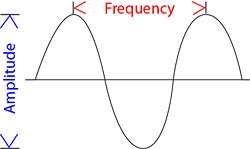Defining Sound
You and your friend are sitting next to each other, sharing ear buds to listen to music. You hear a new song come on and he suddenly starts drawing a picture, following along with the music. As you watch him, you can see how his movements change with the loudness or pace of the music.

Though this is just a simple example of drawing to music, sound waves can actually be broken down into a simple picture, usually in the form of a sine wave. If you watch your friend drawing, you can see him drawing a curved line going up and then down repeatedly, across the page. This is what a sine wave looks like.
Sine waves represent what is called a pure tone. Pure tones are the most basic unit of sound. Have you ever taken a hearing test at school and you had to raise your hand when you hear the beeps? Those beeps are the pure tones.
Characteristics of Sound
Each different sound you heard in your hearing test was likely in a different pitch. This is called frequency. Frequency is the amount of cycles of a wave per second. The unit of frequency is called Hertz. When the frequency is higher, and more waves fit into the same space, the pitch sounds higher, like a bird chirping. When the frequency is lower, and fewer waves fit into the same space, the pitch is lower, like a drum. You can take sounds of different frequencies and combine them to make more complex sounds. This is what happens when you talk or when you make music. Talking and music are most often combinations of lots of individual frequencies, or pitches.

The loudness of the sound is called the amplitude. A very soft sound has low amplitude. A very loud sound has high amplitude. A sound with high amplitude pushes the sound molecules with greater force, creating the increase in loudness that you hear. For example, think about your friend drawing along with the music again. When the music is loud, his picture is very big. When the music is quiet, his picture is very small. This is what amplitude looks like when we draw the sine wave.
Noise is a little different. Some people define noise as anything the listener does not want to hear. Scientists define noise as a random combination of all of the components of sound that does not have any pattern or repeating features. Any one sound has the potential to be in that noise at any period of time.
Additional images via Wikimedia Commons. Sound wave image by Luis Lima89989.
Read more about: How Do We Hear?
Bibliographic details:
- Article: Defining Sound
- Author(s): Dr. Biology
- Publisher: Arizona State University School of Life Sciences Ask A Biologist
- Site name: ASU - Ask A Biologist
- Date published:
- Date accessed:
- Link: https://askabiologist.asu.edu/defining-sound
APA Style
Dr. Biology. (). Defining Sound. ASU - Ask A Biologist. Retrieved from https://askabiologist.asu.edu/defining-sound
Chicago Manual of Style
Dr. Biology. "Defining Sound". ASU - Ask A Biologist. . https://askabiologist.asu.edu/defining-sound
Dr. Biology. "Defining Sound". ASU - Ask A Biologist. . ASU - Ask A Biologist, Web. https://askabiologist.asu.edu/defining-sound
MLA 2017 Style

A representation of sound waves.
Be Part of
Ask A Biologist
By volunteering, or simply sending us feedback on the site. Scientists, teachers, writers, illustrators, and translators are all important to the program. If you are interested in helping with the website we have a Volunteers page to get the process started.

